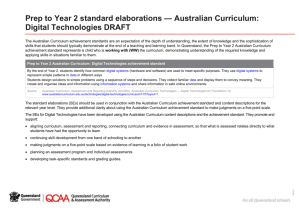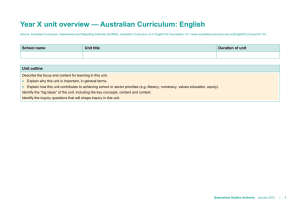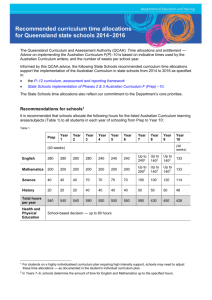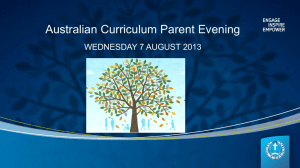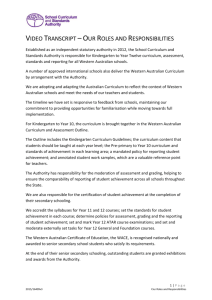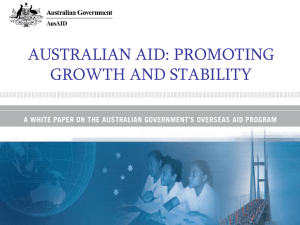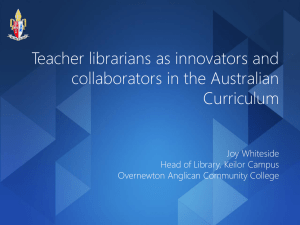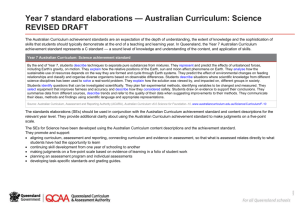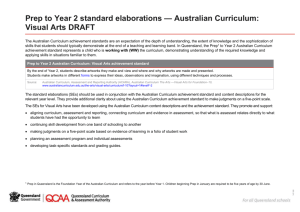Prep Year standard elaborations Australian Curriculum: Science
advertisement
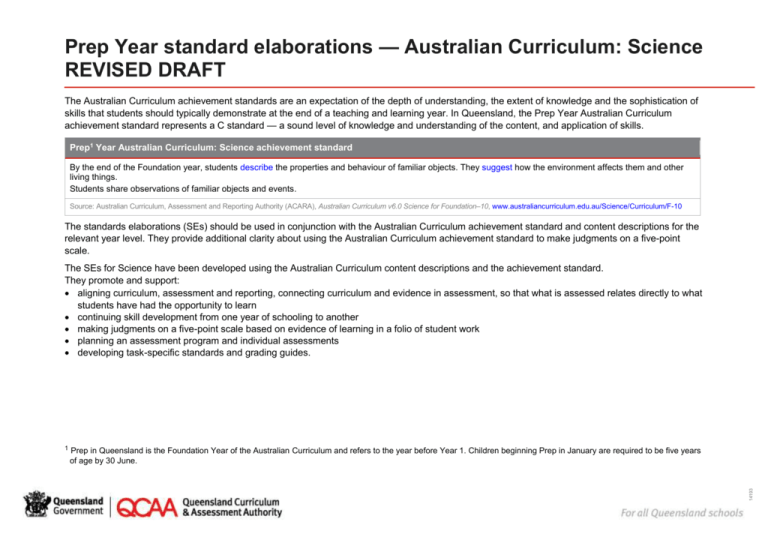
Prep Year standard elaborations — Australian Curriculum: Science REVISED DRAFT The Australian Curriculum achievement standards are an expectation of the depth of understanding, the extent of knowledge and the sophistication of skills that students should typically demonstrate at the end of a teaching and learning year. In Queensland, the Prep Year Australian Curriculum achievement standard represents a C standard — a sound level of knowledge and understanding of the content, and application of skills. Prep1 Year Australian Curriculum: Science achievement standard By the end of the Foundation year, students describe the properties and behaviour of familiar objects. They suggest how the environment affects them and other living things. Students share observations of familiar objects and events. Source: Australian Curriculum, Assessment and Reporting Authority (ACARA), Australian Curriculum v6.0 Science for Foundation–10, www.australiancurriculum.edu.au/Science/Curriculum/F-10 The standards elaborations (SEs) should be used in conjunction with the Australian Curriculum achievement standard and content descriptions for the relevant year level. They provide additional clarity about using the Australian Curriculum achievement standard to make judgments on a five-point scale. The SEs for Science have been developed using the Australian Curriculum content descriptions and the achievement standard. They promote and support: aligning curriculum, assessment and reporting, connecting curriculum and evidence in assessment, so that what is assessed relates directly to what students have had the opportunity to learn continuing skill development from one year of schooling to another making judgments on a five-point scale based on evidence of learning in a folio of student work planning an assessment program and individual assessments developing task-specific standards and grading guides. Prep in Queensland is the Foundation Year of the Australian Curriculum and refers to the year before Year 1. Children beginning Prep in January are required to be five years of age by 30 June. 14193 1 Prep Year Science standard elaborations Applying (AP) Making connections (MC) REVISED DRAFT Working with (WW) Exploring (EX) Becoming aware (BA) Guided description of the properties and behaviour of familiar objects Directed statements about: Guided suggestions of how the environment affects people and other living things • Science Understanding & Science as a Human Endeavour Science Inquiry Skills Skills dimension Understanding dimension The folio of a child’s work has the following characteristics: • • Clear description and explanation, with links to science knowledge, of the properties and behaviour of familiar objects • • Explained suggestions, with links to science knowledge, of how the environment affects people and other living things Description, with links to science knowledge, of the properties and behaviour of familiar objects Suggestions, with links to science knowledge, of how the environment affects people and other living things • • Description of the properties and behaviour of familiar objects Suggestions of how the environment affects people and other living things • • • the properties and behaviour of familiar objects how the environment affects people and other living things Refer to the Foundation Australian Curriculum achievement standard for the depth of conceptual understanding for each of the sub-strands Biological sciences, Chemical sciences, Earth and space sciences and Physical sciences • • Response to questions and making of accurate observations Sharing of observations using relevant scientific terminology • • Response to questions and making of linked observations Sharing of observations of familiar objects and events Guided sharing of observations of familiar objects and events Directed sharing of observations of familiar objects and events Sharing of observations of familiar objects and events using linked scientific terminology Note: Colour highlights have been used in the table to emphasise the qualities that discriminate between the standards. Prep Year standard elaborations — Australian Curriculum: Science REVISED DRAFT Queensland Curriculum & Assessment Authority July 2014 Page 2 of 5 Key AP The child applies the curriculum content and demonstrates a thorough understanding of the required knowledge. The child demonstrates a high level of skill that can be transferred to new situations. EX The child is exploring the curriculum content and demonstrates understanding of aspects of the required knowledge. The child uses a varying level of skills in situations familiar to them. MC The child makes connections using the curriculum content and demonstrates a clear understanding of the required knowledge. The child applies a high level of skill in situations familiar to them, and is beginning to transfer skills to new situations. BA The child is becoming aware of the curriculum content and demonstrates a basic understanding of aspects of required knowledge. The child is beginning to use skills in situations familiar to them. WW The child can work with the curriculum content and demonstrates understanding of the required knowledge. The child applies skills in situations familiar to them. Prep Year standard elaborations — Australian Curriculum: Science REVISED DRAFT Queensland Curriculum & Assessment Authority July 2014 Page 3 of 5 Notes The SEs describe the qualities of achievement in the two dimensions common to all Australian Curriculum learning area achievement standards: understanding skills. Dimension* Description Understanding* The concepts underpinning and connecting knowledge in a learning area, related to a student’s ability to appropriately select and apply knowledge to solve problems in that learning area Skills* The specific techniques, strategies and processes in a learning area The following terms and key words are used in the Prep Year Science SEs. They help to clarify the descriptors and should be used in conjunction with the ACARA Australian Curriculum Science glossary www.australiancurriculum.edu.au/Science/Glossary Term Description Accuracy; Accurate Consistent with a standard, rule, convention or known fact In the context of Science: accurate measurements are close to the accepted value * accurate representations are a true representation of observations or collected data. Clear; Clearly Easy to perceive, understand, or interpret Communicating (sub-strand)* Conveying information or ideas to others through appropriate representations, text types and modes Description; Descriptive; Describe* Give an account of characteristics or features Direction; Directed Following the instructions of the facilitator Explanation; Explanatory; Explain* Provide additional information that demonstrates understanding of reasoning and/or application Fragmented Disjointed, incomplete or isolated Guided Visual and/or verbal prompts to facilitate or support independent action Link To connect with Planning and conducting (sub-strand)* Making decisions regarding how to investigate or solve a problem and carrying out an investigation, including the collection of data In Prep, this includes exploring and making observations by using the senses. Processing and analysing data and information (sub-strand)* Representing data in meaningful and useful ways; identifying trends, patterns and relationships in data, and using this evidence to justify conclusions In Prep, this includes: engaging in discussions about observations using methods such as drawings to represent ideas. The asterisk (*) denotes dimensions and terms described by ACARA. Unmarked terms are described by QCAA. Prep Year standard elaborations — Australian Curriculum: Science REVISED DRAFT Queensland Curriculum & Assessment Authority July 2014 Page 4 of 5 Questioning and predicting (sub-strand)* Identifying and constructing questions, proposing hypotheses and suggesting possible outcomes In Prep this includes responding to questions about familiar objects and events. Relevance; Relevant Applicable and pertinent Science knowledge* Science knowledge refers to facts, concepts, principles, laws, theories and models that have been established by scientists over time. From Foundation (Prep) to Year 2, students learn that observations can be organised to reveal patterns, and that these patterns can be used to make predictions about phenomena. For year level specific information, refer to the Foundation (Prep) Year Level description and content descriptions www.australiancurriculum.edu.au/Science/Curriculum/F-10#levelF Science understanding* Science understanding is evident when a person selects and integrates appropriate science knowledge to explain and predict phenomena, and applies that knowledge to new situations. The Foundation Year Australian Curriculum achievement standard outlines the depth of conceptual understanding for each of the Science understanding sub-strands: Biological sciences Living things have basic needs, including food and water Chemical sciences Objects are made of materials that have observable properties Earth and space sciences Daily and seasonal changes in our environment, including the weather, affect everyday life Physical sciences The way objects move depends on a variety of factors, including their size and shape. Statement; State A sentence or assertion Prep Year standard elaborations — Australian Curriculum: Science REVISED DRAFT Queensland Curriculum & Assessment Authority July 2014 Page 5 of 5

